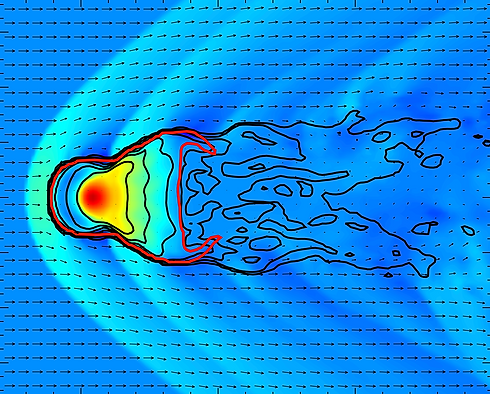Sylvia Ploeckinger
My Research
Galaxies, cosmology and the physical and chemical processes necessary to understand them

The nature of the dark matter particle
Despite great efforts in the particle physics community, the dark matter particle has not been directly detected. The majority of cosmological simulations carried out by different research groups around the world, assume that the dark matter particle is dynamically "cold" (i.e. cold dark matter). In this theory, dark matter haloes can form on scales smaller than the size of the Earth. If the dark matter particle is dynamically "warm", the lowest mass dark matter haloes would have the masses of dwarf galaxies (around 100 million times the mass of the Sun). How different would galaxies look if they were in a Universe with warm dark matter (with the right-handed or sterile neutrino as possible candidate)? Which signal would we expect if dark matter would decay into dark photons? How could this signal be observed?
In the press (14 Oct 2019, Leiden Univ): "A matter of dark matter"
New paper (25 March 2020): Effective photon mass and (dark) photon conversion in the inhomogeneous Universe

Cosmological simulations
Simulations of a representative volume of the Universe are used to test theories on the structure formation in the Universe. How did the zoo of galaxies that we observe today evolve out of tiny density fluctuations more than 13 billion years ago? Why do some galaxies, like the Milky Way, have a galactic disc while other are round? How are the elements that are necessary for life on Earth (for example carbon, oxygen, or iron) produced and distributed in the Universe? Using the worlds largest supercomputers these questions (and so many more) can be investigated in great detail.
Image credit: The EAGLE team (Schaye et al. 2015)

Compact Groups of Galaxies
Galaxies are located in very different environments: from individual isolated galaxies or galaxy pairs (such as the Milky Way Galaxy and Andromeda, to galaxy groups and massive cluster of galaxies. Compact groups of galaxies consist of at least 3-4 galaxies with comparable brightnesses. Because of their proximity as well as their low relative velocities, they are very interesting objects to study galaxy interactions.
Image credit: This is one of the identified compact groups in EAGLE from Hartsuiker & Ploeckinger; visualisation by J. Trayford

Tidal dwarf galaxies
In the current standard model of cosmology all galaxies form within their own dark matter haloes. As smaller haloes collide and merge the haloes as well as the galaxies within them grow in mass. All galaxies? Not all galaxies. There is a small class of objects, called Tidal Dwarf Galaxies, that is observed to form the other way round. Instead of forming more massive galaxies out of less massive object, they are low-mass objects that form out of more massive galaxies. This can happen when gas-rich massive galaxies get too close to each other and their interaction leads to the formation of long tidal arms of gas and stars. The dwarf galaxy-sized objects that form in these tidal arms are the Tidal Dwarf Galaxies. Galaxies without their own dark matter halo.
Image credit: Tidal dwarf galaxy identified in EAGLE;
Ploeckinger et al. (2018)

High velocity clouds
Gas clouds consisting observed mainly as neutral hydrogen clouds are observed outside the disc of the Milky Way Galaxy approaching or receding at high velocities (more than a few hundred km/s). Distance measurements of the more extended clouds place them within the Galactic halo but these measurements are difficult for very compact clouds. Are these compact clumps small and nearby or are they much larger but only appear small because they are far away?
Image credit: Simulation of a high velocity cloud in a wind tunnel; Ploeckinger & Hensler (2012)